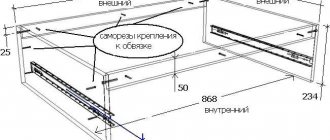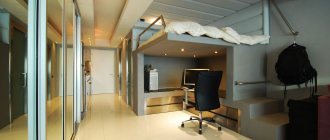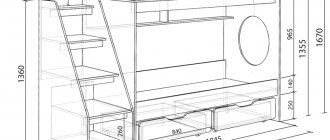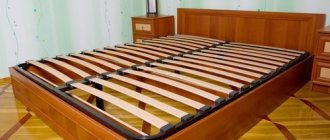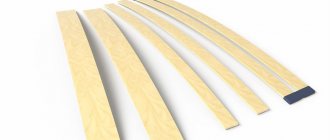A bed is not just a place to sleep. This piece of furniture can be made more functional with an interesting headboard made in the form of cabinets or shelves for books. But this is not the limit of functionality. You can store rarely used items under the bed itself, hiding them from prying eyes. But in this case, free access to boxes and drawers is of particular importance, which can be achieved by equipping the bed with special lifting mechanisms - a pair of pistons operating on the principle of gas lift for the bed.
What is a gas lift, and why do we need it?
This is a special mechanism used to lift and transform furniture elements connected to it. In its principle, this device is similar to a car shock absorber.
The design features of the gas lift lie in its configuration. It consists of:
- a cylinder filled with gas, often nitrogen; It is important to note that the gaseous composition is present inside the cylinder under high pressure, therefore it is not recommended to disassemble such a device with your own hands;
- a piston with a drain, which serves to transmit the applied force to the external environment;
- oil damper, ensuring smooth running due to the shock-absorbing effect.
The purpose of a gas lift for a bed is not limited to just the ability to store things under the bed. Structures equipped with this kind of mechanisms are able to properly support the spine during rest, eliminating joints and uneven surfaces that negatively affect the musculoskeletal system.
How to select and install a kitchen gas lift
Modern furniture, including kitchen cabinets, are equipped with high-quality fittings that make them easier to use. Closers can be installed on cabinet doors to ensure smooth closing, push-opening systems, and so on. A special place among all types of fittings is occupied by gas lift for the kitchen. What is he? For what purposes is equipment installed on kitchen furniture? How to select and install it yourself? The answers follow.
Kitchen gas lift
Design and operating principle of gas lift
The gas lift (gas spring, lift) for kitchen cabinets consists of the following elements:
- outer casing, made in most cases of metal;
- rod and thrust bearing for its smooth sliding;
- gas capsule (in most cases filled with nitrogen);
- sealing gaskets.
Internal structure of a kitchen lift
The gas lift is installed on the doors of kitchen cabinets for smooth opening/closing and holding in a given position. Unlike other types of fittings, the lift:
- can be installed on furniture made of any material;
- allows you to open and close doors without a handle;
- securely locks the door in the open position, preventing excessive opening;
- by compressing and increasing the gas, it allows you to regulate the smooth running of the kitchen façade.
Variety of elevators
Today there are more than enough types of lifting mechanisms, and almost all of them are suitable for installation in a bed structure. They differ only in cost, design features, and service life. The peculiarity of each type of lift lies in the possible force used for a particular design.
Based on the principle of operation, lifts are divided into three types.
Which gas lift to choose
When installing a gas lift in the kitchen, appliances of various lengths and ability to resist load are used. Ease of use and service life depend on the correct selection of the system.
By lenght
Factories produce this equipment in three sizes: 164 mm, 244 mm, 355 mm. Before installing the gas lift on the door, it is necessary to find the distance between the open leaf and the vertical support of the base.
For example, for departments with a side panel height of 365 mm, a 35.5 cm elevator is suitable.
Dimensions are determined in the extended position.
By compression force
When installing a gas lift on a cabinet, the degree of resistance of the piston to the weight of the equipment is taken into account. Standard values for household furniture are considered to be 60 and 80 N. It is unnecessary to buy elevators with a power of 100, 120, 140 N; such units are used when assembling sofas.
It is better to entrust the purchase of a device based on individual characteristics to specialists. In our company, craftsmen will select a suitable product, taking into account the scale, material from which the set is made, and its location in the interior of the room.
Gas
The bed gas lift is based on a simple mechanism that operates smoothly, silently and reliably. If the load is correctly calculated and a shock-absorbing device is selected, such a product can be used for up to 10 years. The bed cabinet includes additional equipment with a pneumatic gas lift with two stops.
Experts recommend choosing the latter option, which is characterized by ease of use and smooth operation. The cost of such a gas lift for a bed is higher compared to analogues, but the use of the device is fully compensated not only by convenience, but also by safety.
Based on the operating principle, elevators are divided into two groups:
- Automatic, not requiring human effort and close control to raise/lower the bed.
- Frictional, with less pressure, but providing for stopping the raised part of the bed in any desired position.
Please note that the former are more popular, therefore they lead in sales on the market.
Installing a gas furniture shock absorber on a kitchen cabinet
A gas shock absorber for horizontally opening doors is one of the most common options for attaching facades to furniture frames.
It is distinguished by its affordable price, simple opening mechanism and ease of installation. For different sizes of facades, there are different furniture gas lifts, differing in the degree of load.
Due to the fact that such a lift has a smooth move, the door opens without much effort, easily and simply, in addition, the entire contents of the cabinet become visible. This is especially true for kitchen sets, in which such a mechanism can be used, first of all, for a cabinet with a built-in drying rack for dishes.
So, let's look at the main technical characteristics of a furniture shock absorber:
- operates using inert gas (nitrogen);
- often made of steel or chrome alloys;
- the cylinder (in other words, the working chamber) is made of steel;
- the working chamber has a wall thickness of 1 mm;
- the temperature range at which the device is capable of functioning is from - 35 C to +80 C;
- the number of lifts that are recommended to be installed on one façade is 2 pcs.
Operating principle of gas furniture elevators
Lifts consist of working chambers (cylinders), friction bearings and oil seals. All these parts create the conditions for hermetically sealed movement of the rod throughout the device. The piston sleeve and bypass valve protect the lift from distortion, and the springs act as dampers.
When opening the fronts upwards:
When the front is closed, the piston rod is recessed in the working area. This is possible thanks to the compressed gas contained in it. When the door opens, the gas pushes the piston in the opposite direction. An oil damper is responsible for smooth running. At the end of the closing cycle, the oil flows, creating a shock absorber effect.
When opening the fronts down:
Shock absorbers for kitchen cabinets that open downwards have a similar structure. But there is also a difference. They differ in that it is necessary to apply more force when opening the door. This is due, first of all, to the fact that the bypass valves have different diameters. Therefore, oil and air flow through holes of different sizes with great force.
Load calculation
Depending on the size of the façade, the required load is selected; it is measured in Newtons.
The load range of gas furniture shock absorbers is: 50N, 60N, 80N, 100N, 120N, 160N, 200N. Furniture makers who have many years of experience in furniture production select the required gas lift by eye. For beginning craftsmen, there are tables with tips, thanks to which you can easily select the right device.
Gas shock absorber selection table:
When choosing a furniture gas lift, you can focus on the following figures - 1 kg of facade (with all the decor and fittings) per 10 newtons.
The colors of gas lifts for furniture that are on the market are white, black and steel.
Types of gas shock absorbers
There are the following types of furniture gas lifts:
- Direct-acting gas lift, that is, this device works to compress the rod (the rod is in full extension);
- A reverse-acting gas lift device is triggered by the extension of the rod (the rod is in a recessed state).
Most often, shock absorbers of direct action are used in the manufacture of furniture.
By installing the device in different ranges, it is possible to ensure that the door opens at different angles. This is especially true for cabinets that are located very high, or, conversely, low.
What are the main advantages of using gas elevators over other fastening fittings?
- Firstly, gas furniture lifts use compressed nitrogen, which does not lead to corrosion of the device, unlike ordinary oxygen. In addition, nitrogen is not capable of damaging the rubber parts of the shock absorber. We can say that this gas greatly extends the service life of the elevator.
- Secondly, using such lifts you can ensure smooth closing of doors even in budget furniture.
- Thirdly, modern hardware manufacturers have launched shock absorbers on the market, the installation of which does not require the use of any tools.
- Fourthly, the large selection of loads that can be used when installing lifts on cabinet fronts allows you to choose the most suitable fittings to open the door silently and with minimal effort.
- Fifthly, gas furniture shock absorbers have a fairly wide temperature range, thanks to which they can be used in any room.
- Sixthly, the material used to make gas lifts (steel) makes these devices reliable and strong.
- Seventhly, the warranty period for these fittings is from ten to one hundred thousand closing and opening cycles, which indicates the high quality of these lifts.
Calculation of gas lift load for a lifting bed
Before you buy a gas lift, you should take into account how much weight it will lift, and based on this, calculate the expected load. This is the main indicator that you will need when choosing a design.
It seems that this is as simple as shelling pears, but there are some nuances here too. Firstly, you will need to take into account the exact weight of the structure, and secondly, you need to know some details:
- the density of the material used to make the bed, which is indicated by the manufacturer, as well as the weight of the structure;
- density of the material and weight of the mattress.
Before you begin installing the gas lift, pay attention to the markings of the device. The numbers on it indicate the load, determined in newtons. Here are a few rules that will help you understand how to calculate gas lift for a bed:
- Approximately 10N supports about 1 kg of structure weight.
- Each of the mechanisms is marked by the manufacturer in increments of 200 units (600N, 800N, 1000N, etc.).
- To distribute the load evenly, gas lifts are mounted in pairs (1 or 2 on each side).
How to choose gas lifts for kitchen furniture
Application of furniture gas elevator.
Its main components. Principle of operation. Advantages. Price of premium gas lifts Hafele. What parameters should be taken into account in order not to make a mistake when choosing a gas lift? Gas elevators are provided for smooth lifting and closing of furniture facades. Lifters that operate by moving a rod under the influence of an inert gas in a sealed cylinder. They allow you to easily open heavy facades upwards and close them smoothly and effortlessly without popping.
Today it is possible to buy gas elevators for sashes weighing up to 9 kg or more. Lifts are used in conjunction with articulated hinges. They are distinguished by ease of installation, reliability and durability.
But for gas lifts to work 100%, you need to choose them correctly. When choosing, several key parameters are taken into account.
Load calculation example
Your bed weighs 80 kg together. This means that for lifting you will need two furniture gas lifts for a bed marked from 800N. Theoretically, a system of this volume can lift a weight of up to 160 kg, but in practice this does not happen due to the fact that the forces are distributed at an angle.
Do not forget that over time the forces of the devices weaken, so it is permissible to take the model one step larger than the weight of your structure. Just do not buy a gas lift that is too powerful, otherwise it will be difficult to raise and lower the bed frame due to insufficient weight and too high gas pressure in the cylinder.
As you can see, even when choosing a gas lift for a folding bed you should be extremely careful. Taking into account all the described rules and recommendations, you will be able to choose a product that matches the characteristics of your bed. And the long service life of the structure depends on the right choice.
Types of furniture gas lifts, rules for selection and installation
Repair and maintenance
Gas lifts can be found in any modern kitchen where cabinet furniture is installed. They are used in cabinets whose fronts open upward and secure the doors in the open position. A furniture gas lift is a lift with a piston and cylinder containing inert gas. The gas prevents sudden compression and expansion of the spring in the lift, creating a shock-absorbing effect. The simple and effective design has found wide application in various industries.
Scope of gas lifts
Gas elevators have proven themselves in the automotive industry - initially they were installed on hoods and trunks, and also mounted in car doors. Lifts are needed to take on the weight of structures and protect them from damage.
Today, gas lifts, in addition to the automotive industry, are widely used in other areas:
- Furniture industry - first of all, we are talking about kitchen furniture. Gas lifts are ideal for cabinets that open upward. They prevent doors from closing spontaneously and allow you to save space in the kitchen. Also, furniture gas lifts are installed in office chairs, folding sofas, wardrobe beds;.
- Construction - used in the production of doors, window frames and glass display cases;
- Medical equipment - used in the manufacture of beds for the care of palliative patients, in the production of simulators for rehabilitation procedures and other equipment;
- Printing - gas shock absorbers are installed on the covers of copiers, scanners, MFPs and other devices;
- Weapons sphere - used for the manufacture of pneumatic weapons;
- Aerospace construction and others;
Below we will talk about the features of furniture gas lifts.
Varieties
Depending on the application, the design of gas shock absorbers will differ. According to the direction of action there are:
- Direct acting gas lifts compress the rod. This means that in the basic assembly the stem is fully extended. Such devices are most widely used in furniture production;
- Reverse-acting gas lifts—extend a rod recessed in the base assembly.
Also, gas lifters differ in the pressure in the cylinder. Based on this principle, a distinction is made between high and low pressure springs. High pressure lifters consist of two main elements: a rod and a cylinder, which is filled with inert gas. The design of such a device cannot be disassembled. The principle of operation is based on the fact that the gas pushes the rod out of the cylinder. Immersion of the rod into the cylinder leads to a decrease in the volume of gas storage and an increase in pressure in the spring. The low pressure lifter is made of two hollow cylinders filled with compressed gas. Compressing the gas increases its volume and increases the pressure inside the spring.
Direct action
Reverse action
Low-pressure gas lifts are characterized by an almost unlimited service life and the possibility of independent adjustment and maintenance.
Another type of gas shock absorbers is locking springs. The block can be located on the pressure tube or on the rod. Such devices are used, for example, in office chairs for height adjustment. The piston rod has a locking function with a button that opens the piston valve. After pressing the button, the rod can be pressed in or out. Releasing the button causes the rod to lock in the specified position.
